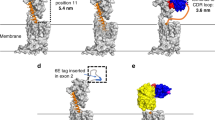Abstract—
Anti-mullerian hormone (AMH), a homodimeric glycoprotein, described over 70 years ago by A. Jost, is the least studied member of the transforming growth factor beta superfamily. Despite the antitumor activity of AMH discovered at the end of the last century, creation of effective AMH-based drugs is hampered primarily by the lack of information on the mechanism of interaction of various AMH forms with a specific type II receptor (MISRII). Previously, we have shown that not only the full-length activated hormone but also its C-terminal fragment (C-rAMH) could bind to MISRII. In this work, using the surface plasmon resonance technique, we have compared the interaction of three forms of recombinant AMH (rAMH) with the MISRII analogue—the chimeric protein MISRII-Fc containing AMH type II receptor and-Fc fragment of the human IgG1 heavy chain. Comparison of the binding of MISRII-Fc, immobilized on a chip with group specificity for human immunoglobulins, to C-rAMH, to intact rAMH (pro-rAMH), and to rAMH containing one uncleaved monomer (hc-rAMH), showed that the KD of the complexes increased: 1.7 nM, 88 nM and 110 nM, respectively. Thus, we have shown that the C-terminal fragment of AMH exhibits the maximum affinity for the recombinant MISRII analogue, thus indicating the prospects for the development of drugs based on this hormone derivative.





Similar content being viewed by others
REFERENCES
Tsimberidou, A.M., Cancer Chemother. Pharmacol., 2015, vol. 76, no. 6, pp. 1113–1132. https://doi.org/10.1007/s00280-015-2861-1
Gharpure, K.M., Wu, S.Y., Li, C., Lopez-Berestein, G., and Sood, A.K., Clin. Cancer Res., 2015, vol. 21, no. 14, pp. 3121–3130. https://doi.org/10.1158/1078-0432.CCR-14-1189
MacLaughlin, D.T. and Donahoe, P.K., Future Oncol., 2010, vol. 6, no. 3, pp. 391–405. https://doi.org/10.2217/fon.09.172
McLennan, I.S. and Pankhurst, M.W., J. Endocrinol., 2015, vol. 226, no. 3, pp. R45–R57. https://doi.org/10.1530/JOE-15-0206
Rey, R., Lukas-Croisier, C., Lasala, C., and Bedecarrás, P., Mol. Cell. Endocrinol., 2003, vol. 211, nos. 1–2, pp. 21–31. https://doi.org/10.1016/j.mce.2003.09.007
Lane, A.H. and Donahoe, P.K., J. Endocrinol., 1998, vol. 158, vol. 1, pp. 1–6. https://doi.org/10.1677/joe.0.1580001
Pankhurst, M.W., Leathart, B.L.A., Batchelor, N.J., and McLennan, I.S., Endocrinology, 2016, vol. 157, no. 4, pp. 1622–1629. https://doi.org/10.1210/en.2015-1834
Rak, A.Ya., Trofimov, A.V., Stefanov, V.E., and Ischenko, A.M., Biol. Comm., 2019, vol. 64, no. 3, pp. 201–210. https://doi.org/10.21638/spbu03.2019.304
Josso, N., Belville, C., di Clemente, N., and Picard, J.Y., Hum. Reprod. Update, 2005, vol. 11, vol. 4, pp. 351–356. https://doi.org/10.1093/humupd/dmi014
Durlinger, A.A.L.L., Visser, J.J.A., and Them-men, A.A.P.N., Reproduction, 2002, vol. 124, pp. 601–609. https://doi.org/10.1530/rep.0.1240601
Sriraman, V., Niu, E., Matias, J.R., Donahoe, P.K., MacLaughlin, D.T., Hardy, M.P., and Lee, M.M., J. Androl., 2001, vol. 22, no. 5, pp. 750–758. https://doi.org/10.1002/j.1939-4640.2001.tb02577.x
Kim, J.H., MacLaughlin, D.T., and Donahoe, P.K., Obstet. Gynecol. Sci., 2014, vol. 57, no. 5, pp. 343–357. https://doi.org/10.5468/ogs.2014.57.5.343
Donahoe, P.K., Clarke, T., Teixeira, J., Maheswaran, S., and MacLaughlin, D.T., Mol. Cell. Endocrinol., 2003, vol. 211, nos. 1–2, pp. 37–42. https://doi.org/10.1016/j.mce.2003.09.009
Beck, T.N., Korobeynikov, V.A., Kudinov, A.E., Georgopoulos, R., Solanki, N.R., Andrews-Hoke, M., Kistner, T.M., Pepin, D., Donahoe, P.K., Nicolas, E., Einarson, M.B., Zhou, Y., Boumber, Y., Proia, D.A., Serebriiskii, I.G., and Golemis, E.A., Cell Rep., 2016, vol. 16, no. 3, pp. 657–671. https://doi.org/10.1016/j.celrep.2016.06.043
Barbie, T.U., Barbie, D.A., MacLaughlin, D.T., Maheswaran, S., and Donahoe, P.K., Proc. Natl. Acad. Sci. USA, 2003, vol. 100, no. 26, pp. 15601–15606. https://doi.org/10.1073/pnas.2636900100
Pépin, D., Sosulski, A., Zhang, L., Wang, D., Vathipadiekal, V., Hendren, K., Coletti, C.M., Yu, A., Castro, C.M., Birrer, M.J., Gao, G., and Dona-hoe, P.K., Proc. Natl. Acad. Sci. USA, 2015, vol. 112, no. 32, pp. E4418–E4427. https://doi.org/10.1073/pnas.1510604112
Bakkum-Gamez, J.N., Aletti, G., Lewis, K.A., Keeney, G.L., Thomas, B.M., Navarro-Teulon, I., and Cliby, W.A., Gynecol. Oncol., 2008, vol. 108, no. 1, pp. 141–148. https://doi.org/10.1016/j.ygyno.2007.09.010
Kersual, N., Garambois, V., Chardès, T., Pouget, J.P., Salhi, I., Bascoul-Mollevi, C., Bibeau, F., Busson, M., Vie, H., Clemenceau, B., Behrens, C.K., Estupina, P., Pelegrin, A., and Navarro-Teulon, I., MAbs, 2014, vol. 6, no. 5, pp. 1314–1326. https://doi.org/10.4161/mabs.29316
Song, J.Y., Chen, K.Y., Kim, S.Y., Kim, M.R., Ryu, K.S., Cha, J.H., Kang, C.S., Maclaughlin, D.T., and Kim, J.H., Int. J. Oncol., 2009, vol. 34, no. 6, pp. 1583–1591. https://doi.org/10.3892/ijo_00000288
Barnholtz-Sloan, J.S., Schwartz, A.G., Qureshi, F., Jacques, S., Malone, J., and Munkarah, A.R., Am. J. Obstet. Gynecol., 2003, vol. 189, no. 4, pp. 1120–1127. https://doi.org/10.1067/S0002-9378(03)00579-9
Jost, A., Recent Progr. Hormon Res., 1953, vol. 8, pp. 379–413.
Cate R.L., Donahoe P.K., MacLaughlin D.T., in Peptide Growth Factors and Their Receptors II, Sporn, M.B. and Roberts, A.B., Eds., Heidelberg: Springer, 1990, pp. 179–210.
Rak, A.Ya., Trofimov, A.V., Pigareva, N.V., Simbirtsev, A.S., and Ischenko, A.M., Cell Tissue Biol., 2018, vol. 12, no. 6, pp. 460–467. https://doi.org/10.1134/S1990519X18060093
Rak, A.Ya., Trofimov, A.V., Pigareva, N.V., Protasov, E.A., Karabanova, E.A., and Ischenko, A.M., Biomed. Chromatogr., 2020, vol. 34, no. 5, e4782. https://doi.org/10.1002/bmc.4782
Westermeier, R., Electrophoresis in Practice: A Guide to Methods and Applications of DNA and Protein Separations, Weinheim: Wiley-VCH Verlag, 2016.
Hall, T.A., Nucl. Acid. S., 1999, vol. 41, pp. 95–98.
Lu, G. and Moriyama, E.N., Brief. Bioinform., 2005, vol. 5, pp. 378–388. https://doi.org/10.1093/bib/5.4.378
Mahmood, T. and Yang, P.C., North Am. J. Med. Sci., 2012, vol. 4, no. 9, pp. 429–434. https://doi.org/10.4103/1947-2714.100998
ACKNOWLEDGMENTS
The authors are very grateful to the staff of the Laboratory of Biochemical Genetics of the Department of Molecular Genetics of the Institute of Experimental Medicine for providing equipment and assistance in experiments.
Funding
The work was performed within the framework of the State Contract no. 14.N08.11.0104 dated August 25, 2016.
Author information
Authors and Affiliations
Corresponding author
Ethics declarations
The authors declare that there is no conflict of interest. This work does not contain any studies involving animals or human participants as research objects.
Additional information
Translated by A. Medvedev
Rights and permissions
About this article
Cite this article
Rak, A.Y., Trofimov, A.V., Ischenko, A.M. et al. Interaction Study of Different Forms of Human Recombinant Anti-Mullerian Hormone with a Chimeric Analogue of the AMH Type II Receptor. Biochem. Moscow Suppl. Ser. B 15, 232–240 (2021). https://doi.org/10.1134/S1990750821030082
Received:
Revised:
Accepted:
Published:
Issue Date:
DOI: https://doi.org/10.1134/S1990750821030082




